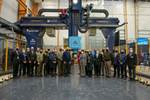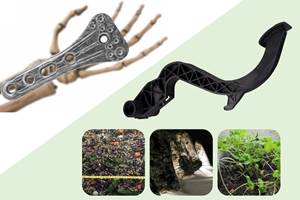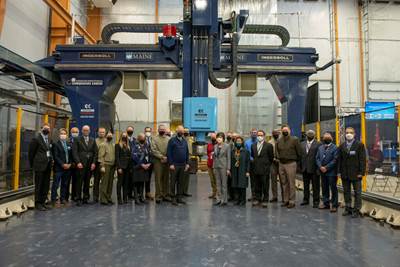University of Maine unveils 100% bio-based 3D-printed home
BioHome3D, made of wood fibers and bioresins and entirely 3D printed, highlights Maine’s effort to address the need for more affordable housing.
On Nov. 21, the University of Maine Advanced Structures and Composites Center (UMaine ASCC, Orono, Maine, U.S.) unveiled BioHome3D, a 3D-printed house made entirely with bio-based materials. BioHome3D was developed with funding from the U.S. Department of Energy’s (DOE) Hub and Spoke
program between UMaine and Oak Ridge National Laboratory (ORNL, Knoxville, Tenn., U.S.). Partners included MaineHousing (Augusta) and the Maine Technology Institute (MTI, Brunswick).
The 600-square-foot prototype features 3D-printed floors, walls and a roof comprised of wood fibers and bioresins. The house is fully recyclable and highly insulated with 100% wood insulation and customizable R-values. Construction waste was nearly eliminated due to the precision of the
printing process. More importantly, the technology used is designed to address labor shortages and supply chain issues that are driving high costs and constricting the supply of affordable housing — this includes less time for on-site building and printing using abundant, renewable, locally sourced wood fiber feedstock.
“Our state is facing the perfect storm of a housing crisis and labor shortage, but the University of Maine is stepping up once again to show that we can address these serious challenges with trademark Maine ingenuity,” Gov. Janet Mills says.
The U.S. and Maine, in particular, are experiencing a crisis-level shortage of affordable housing. The National Low Income Housing Coalition reports that nationally, there is a need for more than seven million affordable housing units. In Maine alone, the deficit is 20,000 housing units and growing each year, according to the Maine Affordable Housing Coalition. Nearly 60% of
low-income renters in Maine spend more than half of their income on housing. This untenable situation is exacerbated by the twin challenges of a labor shortage and supply chain-driven material price increases.
Using the advanced manufacturing processes and materials developed at UMaine, future low-income homes can be customized to meet a homeowner’s space, energy efficiency and aesthetic preferences. Importantly, as the manufacturing technology and materials production are scaled up, homebuyers can expect faster delivery schedules.
“We are finding solutions here at ASCC to the pressing problems that our world faces and that Maine faces, through research on transformative offshore wind technology, next-generation solutions for transportation infrastructure, advanced forest products and large-scale 3D printing and of course, affordable housing,” UMaine President Joan Ferrini-Mundy says. “The work that goes on in this lab exemplifies the work of a land grant institution — an institution that was started in order to help to solve the problems of, and further the economic advancement of, the state of Maine in partnership with the people of Maine.”
The prototype is currently sited on a foundation outside ASCC, equipped with sensors for thermal, environmental and structural monitoring to test how BioHome3D performs through a Maine winter. Researchers expect to use the data collected to improve future designs.
BioHome3D was printed in four modules, then moved to the site and assembled in half a day. Electricity was running within two hours with only one electrician needed on site.
“Many technologies are being developed to 3D print homes, but unlike BioHome3D, most are printed using concrete. However, only the concrete walls are printed on top of a conventionally cast concrete foundation. Traditional wood framing or wood trusses are used to complete the
roof,” Dr. Habib Dagher, ASCC executive director, explains. “Unlike the existing technologies, the entire BioHome3D was printed, including the floors, walls and roof. The biomaterials used are 100% recyclable, so our great-grandchildren can fully recycle BioHome3D.”
According to the United Nations Environment Programme, buildings account for nearly 40% of global carbon emissions. Sustainably grown wood fiber is a renewable resource that captures carbon during the tree growth cycle. BioHome3D may be thought of as a carbon storage and sequestration unit during its lifetime and after it is recycled.
This project is the product of strong partnerships in and beyond the UMaine community. The DOE-funded Hub and Spoke Program between UMaine and ORNL is leading the research and development (R&D) of sustainable, cost-effective bio-based 3D printing feedstock alternatives, such as the material used for BioHome3D. The Hub and Spoke program is a direct result of a request initiated in 2016 by Sens. Collins and Angus King for a U.S. Department of Commerce Economic Development Assessment team to help Maine bolster the forest economy and create jobs and opportunity in rural regions of the state following the closure of several large paper mills. The
Maine Technology Institute supported the design of the prototype, and MaineHousing was a key partner in developing and reviewing the specifications for the home in alignment with low-income housing standards.
“This program shows the power of scientific collaboration to address critical national needs,” Xin Sun, associate laboratory director for energy science and
technology with ORNL, says. “Uniting the capabilities and facilities of ORNL with UMaine’s expertise and drive for innovation, we have together achieved a significant milestone in the development of sustainable materials and manufacturing technologies, and decarbonizing the buildings sector.”
The BioHome3D prototype was printed via a polymer 3D printer, which, in 2019, produced the world’s largest 3D-printed boat, according to the ASCC. The institute will be able to further scale its advanced manufacturing research in housing construction with the opening of the Green Engineering and Materials (GEM) research Factory of the Future. When complete, GEM will serve as a hub for AI-enabled, large-scale digital hybrid manufacturing,
with bays dedicated to scaling up the production of housing, such as BioHome3D, as well as boatbuilding, an important Maine industry.
GEM is also at the core of the university’s plan to create the new Maine College of Engineering, Computing and Information Science’s (MCECIS), which integrates engineering and computing education and research, driving the workforce of the future through immersive world-class educational opportunities.
Related Content
Cryo-compressed hydrogen, the best solution for storage and refueling stations?
Cryomotive’s CRYOGAS solution claims the highest storage density, lowest refueling cost and widest operating range without H2 losses while using one-fifth the carbon fiber required in compressed gas tanks.
Read MoreOverair's Butterfly eVTOL prototype to integrate composites-intensive design
Aiming for first flight tests in the latter half of 2023, Overair’s Butterfly aircraft uses Toray carbon fiber/epoxy prepreg strategically to cut weight on its battery-powered, quiet aircraft.
Read MoreBioabsorbable and degradable glass fibers, compostable composite parts
ABM Composite offers sustainable options and up to a 60% reduction in carbon footprint for glass fiber-reinforced composites.
Read MoreParis Air Show 2023 highlights
The Paris Air Show, one of the largest aerospace trade shows in the world, returned for the first time since 2019 and proved that the global aviation industry industry is very much alive and kicking.
Read MoreRead Next
UMaine Composites Center 3D prints logistics vessel for U.S. Department of Defense
Two 3D-printed vessels capable of transporting two shipping containers and a Marine rifle squad with three days of supplies mark groundbreaking composite manufacturing milestone.
Read MoreMighty Buildings completes 3D-printed zero net energy home, expands B2B growth
Fiber-reinforced 3D-printed home incorporating the panelized Mighty Kit system is part of a future community of 40+ units designed to provide environmental and economic benefits.
Read MoreComposites end markets: Energy (2024)
Composites are used widely in oil/gas, wind and other renewable energy applications. Despite market challenges, growth potential and innovation for composites continue.
Read More



























